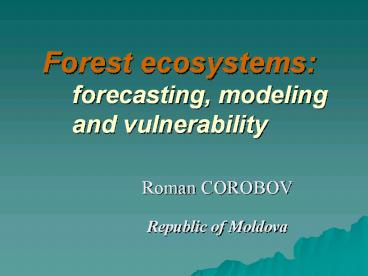Forest ecosystems: forecasting, modeling and vulnerability - PowerPoint PPT Presentation
Title:
Forest ecosystems: forecasting, modeling and vulnerability
Description:
Principal steps in the assessment of ecosystem sensitivity to climate change ... Quercetum aegopodiosum (podagrariae) Q. sambucosum (nigrae) Q, corylosum (avelanae) ... – PowerPoint PPT presentation
Number of Views:170
Avg rating:3.0/5.0
Title: Forest ecosystems: forecasting, modeling and vulnerability
1
Forest ecosystems forecasting, modeling and
vulnerability
- Roman COROBOV
- Republic of Moldova
2
Principal steps in the assessment of ecosystem
sensitivity to climate change
3
Forming the Moldovas Natural Ecosystems
4
Step 1. Natural forests - historical aspect
Forest areas
Northern forest
Beech forests
Codru
Oak-hornbeam
Southern forests
Oaks occupy about half of all forest territory
5
Dynamic of forest fund
1848 1861 1875 1893 1914
1918 1925 1965 1985 1997
Most forests were cut before the 1850s, with the
lowest forest cover in 1918-1925. At present,
forests occupy only about 9-10 of Moldova
territory
6
Changes in forest composition (1925-2000)
1925 1962 1985
1997
In the 20th century some increase of oak forests
and maximal decrease of beech ones took place,
along with significant increase of introducents
share.
7
Step 2 Development of ecological rows as the
model of natural ecosystems change in new
climatic conditions
Essence of the method Todays temporal and
spatial transition from ones plant types to the
others is used as an objective criterion for
assessment of the directions and parameters of
natural ecosystem qualitative changes in new
climate
8
Ecological row of meadow ecosystems
Fresh and dry meadow
When runoff decreases
Bottomland meadow
When runoff increases
Grass marsh
9
Ecological row of flood plain forest community
depending on humidity conditions
10
Step 3 Assessment of forest stability
sensitivity by ecological demands of dominant
species to temperature and precipitation
Ecological range Ecological range Ecological range Ecological range Ecological range Ecological range Ecological range
Edificators Precipitation Precipitation Precipitation Precipitation Annual temperature Annual temperature Annual temperature
Edificators Suboptimum Suboptimum Optimum Limit Suboptimum Optimum Limit
Fagus sylvatica 600 1300 600 1300 700-1200 500 1400 4 10 6 - 9 3
Carpinus betulus 500 800 500 800 600-700 400 900 6 11 8 - 10 5
Quercus petraea 500 900 500 900 600-800 1000 1100 6711 8 - 10 5
Quercus robur 350-560 350-560 600-800 900 7 8 -10 6
Quercus pubescens 450 450 500-650 700 9 - 11 - 8
Co-edificators Co-edificators Co-edificators Co-edificators Co-edificators Co-edificators Co-edificators Co-edificators
Tilia tomentosa 500 550-600 550-600 400 8.5 9 - 11 8
Fraxinus excelsior 450800900 500-700 500-700 400 1000 6711 8 - 10 5
Beula pendula 600 1200 700-1100 700-1100 500 1300 3 4 5 - 8 2-10-11
Ulmus carpinifolia 400 600 450-550 450-550 700 7 8 - 10 11
Acer pseudoplatanus 700 800-1100 800-1100 5006001200 489 5 --7 10
In baseline climate outside of optimum conditions
are Quercus pubescens - by temperature, Fagus
sylvatica - by humidity. Quercus robur has most
wide ecological amplitude by humidity factor.
11
Disposition of key forest species in their area
?????
North
South
Fagus sylvatica
Carpinus betulus
Quercus petraea
Quercus robur
Quercus pubescens
Tilia tomentosa Tilia platyphyllos Malus
sylvestris Pyrus pyrester Ulmus carpinifolia
Fraxinus excelsior Acer campestris Acer
tatarica Viburnum lantana Cerasus avium Tilia
cordata
Sorbus domestica Carpinus orientalis Cotinus
coggygria Ligustrum vulgare Rhamnus
tinctoria Crataegus pentagyna Pyrus elaeagnifolia
Acer pseudoplatanus Sorbus torminalis Hedera helix
Acer pseudoplatanus
12
Sensitivity of forest species to climatic changes
13
Statistical comparison of temperature
precipitation effects on streamflow
14
Simple and cross-correlation between monthly
(left) and annual (right) underground water level
and precipitation
r 0.075
r 0.165
15
- Step 4-5 Projections of change under different
climate change scenarios
16
SRES A2 based climate of forest habitats
17
Remaining uncertainties (IPCC, 2007)
- although not completely quantified, many species
can achieve rapid large-scale migrations, under a
considerable range of lagged responses - future landscapes will differ substantially from
past climate change situations and landscape
fragmentation creates major obstacles to
migration - migration is moderated by such processes as
competition, soil formation, land use,
herbivores, pathogens - tree species do not only respond to a changing
climate by migration, but also by local
adaptation, including genetic one.































